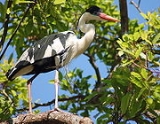
Higher waterbird
Encyclopedia
The higher waterbirds or waterbird assemblage are a hypothetical clade
of aquatic
birds. Gerald Mayr proposed the scientific name Aequornithes (from Latin
aequor, expanse of water + Greek
ornithes, birds) and defined this clade as "the least inclusive clade containing Gaviidae and Phalacrocoracidae". It is supported by at least one recent phylogenetic study.
As proposed, it includes the orders Gaviiformes
, Sphenisciformes, Procellariiformes
, Ciconiiformes
, Suliformes
and Pelecaniformes
. It does not include several unrelated groups of aquatic birds such as flamingo
s and grebe
s (Mirandornithes
), shorebirds and auk
s (Charadriiformes
), or the Anseriformes
.
Clade
A clade is a group consisting of a species and all its descendants. In the terms of biological systematics, a clade is a single "branch" on the "tree of life". The idea that such a "natural group" of organisms should be grouped together and given a taxonomic name is central to biological...
of aquatic
Aquatic animal
An aquatic animal is an animal, either vertebrate or invertebrate, which lives in water for most or all of its life. It may breathe air or extract its oxygen from that dissolved in water through specialised organs called gills, or directly through its skin. Natural environments and the animals that...
birds. Gerald Mayr proposed the scientific name Aequornithes (from Latin
Latin
Latin is an Italic language originally spoken in Latium and Ancient Rome. It, along with most European languages, is a descendant of the ancient Proto-Indo-European language. Although it is considered a dead language, a number of scholars and members of the Christian clergy speak it fluently, and...
aequor, expanse of water + Greek
Ancient Greek
Ancient Greek is the stage of the Greek language in the periods spanning the times c. 9th–6th centuries BC, , c. 5th–4th centuries BC , and the c. 3rd century BC – 6th century AD of ancient Greece and the ancient world; being predated in the 2nd millennium BC by Mycenaean Greek...
ornithes, birds) and defined this clade as "the least inclusive clade containing Gaviidae and Phalacrocoracidae". It is supported by at least one recent phylogenetic study.
As proposed, it includes the orders Gaviiformes
Gaviiformes
Gaviiformes is an order of aquatic birds containing the loons or divers and their closest extinct relatives. Modern gaviiformes are found in many parts of North America and northern Eurasia , though prehistoric species were more widespread.-Classification and evolution:There are five living...
, Sphenisciformes, Procellariiformes
Procellariiformes
Procellariiformes is an order of seabirds that comprises four families: the albatrosses, petrels and shearwaters, storm petrels, and diving petrels...
, Ciconiiformes
Ciconiiformes
Traditionally, the order Ciconiiformes has included a variety of large, long-legged wading birds with large bills: storks, herons, egrets, ibises, spoonbills, and several others. Ciconiiformes are known from the Late Eocene...
, Suliformes
Suliformes
The Order Suliformes is a proposed order by the International Ornithologist's Union...
and Pelecaniformes
Pelecaniformes
The Pelecaniformes is a order of medium-sized and large waterbirds found worldwide. As traditionally—but erroneously—defined, they encompass all birds that have feet with all four toes webbed. Hence, they were formerly also known by such names as totipalmates or steganopodes...
. It does not include several unrelated groups of aquatic birds such as flamingo
Flamingo
Flamingos or flamingoes are gregarious wading birds in the genus Phoenicopterus , the only genus in the family Phoenicopteridae...
s and grebe
Grebe
A grebe is a member of the Podicipediformes order, a widely distributed order of freshwater diving birds, some of which visit the sea when migrating and in winter...
s (Mirandornithes
Mirandornithes
Mirandornithes is a clade that consists of flamingos and grebes. The relationships of both groups have been problematic. Flamingos had been placed with numerous branches within Neognathae, such as ducks and storks. The grebes had been placed with the loons. However recent studies seem to confirm...
), shorebirds and auk
Auk
An auk is a bird of the family Alcidae in the order Charadriiformes. Auks are superficially similar to penguins due to their black-and-white colours, their upright posture and some of their habits...
s (Charadriiformes
Charadriiformes
Charadriiformes is a diverse order of small to medium-large birds. It includes about 350 species and has members in all parts of the world. Most Charadriiformes live near water and eat invertebrates or other small animals; however, some are pelagic , some occupy deserts and a few are found in thick...
), or the Anseriformes
Anseriformes
The order Anseriformes contains about 150 living species of birds in three extant families: the Anhimidae , Anseranatidae , and the Anatidae, which includes over 140 species of waterfowl, among them the ducks, geese, and swans.All species in the order are highly adapted for an aquatic existence at...
.

